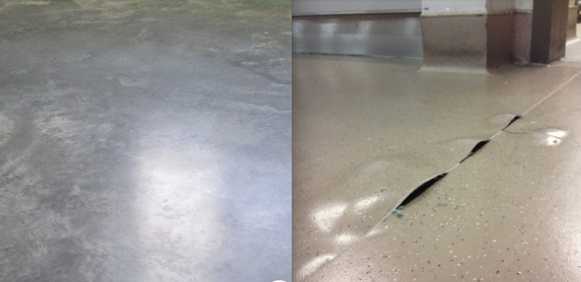|
Contributed by Chris Maskell Is there a problem with flooring glued to concrete with a high fly ash content? Fly ash is the finely divided residue that results from the combustion of ground or powdered coal and that is transported by flue gasses. It is used as a replacement for Portland cement in concrete and in some cases can add to the final strength, increase its chemical resistance and durability and can significantly improve the workability of concrete. If you talk to enough flooring professionals on the subject of site preparation and related issues, eventually the question of concrete, high fly ash content and adhesive bond failure will crop up. I've heard the question from all corners of the commercial flooring industry, and there are many concerns, but few definitive answers. As a result, many commercial flooring contractors are not warrantying their installations over such concrete. Instead, they add a disclaimer in their 'terms and conditions’ stating that no installation warranty is offered when a certain percentage level of fly ash in the concrete mix is exceeded. Some say 15%, others 20 to 25%, some say more. Such disclaimers won't protect the flooring contractor if there is a failure and things turn nasty. Concrete with a high fly ash content results in a denser, less porous product. This in turn can interfere with the flooring adhesive’s (or hydraulic cement underlayment's) ability to mechanically bond. Hard troweling of the concrete surface to a super smooth finish adds to the problem, and introduces the need for shot blasting. Shot blasting requires time and money, both of which are in short supply at the end of the project when the flooring is scheduled. As concrete mixes are proprietary to the concrete supplier, it can be difficult to confirm exactly how much fly ash is present in any one mix. If this is the case or where the concrete is super smooth, unusual in color, or if you are just not sure, then perform a water absorbency test in accordance with ASTM F-3191 and/or a bond test prior to installation. Place dime sized droplets of water on the cleaned concrete surface, if they are not absorbed after 60 seconds (or in accordance with ASTM F-3191), you could be facing an adhesive bond issue. If this is the case then you need to shot blast to a concrete surface profile (CSP) of 1 or 2, or per adhesive manufacturers’ requirements depending on the floor covering to be installed. (A CSP 2 for example, is similar to 60 grit sandpaper) Change to an adhesive that is recommended for non-porous substrates. Consult the manufacturer and again, perform a bond test. Remember that the floor covering manufacturers’ installation requirements will likely be met, but what about the adhesive manufacturers’? This is the important one, because any flooring system is only as good as its bond to the sub-floor.
Also, old emulsifiers and cutting oils hiding in the concrete can cause all kinds of problems if they aren't identified prior to installation. Bond tests won’t always be affected, as the emulsifiers and oils can take time to eat away at the new adhesive. Calcium Chloride Tests Are Part of the Problem The industry is talking about the Anhydrous Calcium Chloride moisture test (ASTM F1869) method not being reliable over such concrete because of its density. The recommended test method is the RH, In-Situ Probe (ASTM F2170-16). This test gives a true moisture reading at a 40% depth in the slab. (Editor's Note: you can read about the latest on F2170 in this post) In many cases both test methods are called for, as they are designed to measure different moisture related characteristics of concrete and are important when establishing proof that acceptable conditions existed prior to flooring installation. Because fly ash is a by-product of burning coal, using this waste product in concrete makes financial and environmental sense and it's easy to see why its use will likely increase over time. Meanwhile, the advice remains the same:
(Editor's Note: Chris Maskell is the CEO of The National Floor Covering Association (NFCA) in Canada, which promotes industry standards for resilient, carpet, hardwood, laminate, cork and bamboo floor covering installations. Their mission is to engage professionals in the construction industry through education and compliance to national floor covering installation standards which provide a quality assurance platform to ensure successful installations on commercial projects.
9 Comments
Roy Schauffele, FCSI, CCPR, FABAA, CABS
11/13/2018 10:15:20 am
Chris, I had problems a few years ago with a penetrating water repellent used on a high fly ash content concrete, didn't go well for anybody.
Reply
12/16/2019 12:25:02 pm
It's good to know that concrete with high fly ash content results in denser flooring. My boss has been telling me about how he wants to make sure that the floor in the warehouse can stand up to anything that gets thrown at it in the coming months. I'll share this information with him so that he can look into his options for professionals who can help him get the right type of concrete poured in the future.
Reply
4/26/2020 05:59:37 pm
Nice Article. Thank you for sharing. Appreciate the information.
Reply
12/15/2020 06:17:24 am
I was looking for this information on the caution flooring. You have really eased my work by posting this article, loved your writing skill as well. Please keep sharing more, would love to read more from you!!If possible visit this website Modbuildhomes.co.nz to gain more idea or tips on the same.
Reply
12/16/2020 03:47:25 am
From this article you will get to know about the caution flooring high fly ash in concrete. I enjoyed reading this article as it provided me lots of information regarding it. You will get best review over here and would suggest others too.I have also found this resource Jagas.co.nz useful and its related to what you are mentioning.
Reply
12/16/2020 06:58:05 am
Wonderful information, thanks a lot for sharing kind of content with us. Your blog gives the best and the most interesting information on the caution flooring high fly ash in concrete in detail. I wonder if we can gather such practical information about it, a great post definitely to come across.I have also found this resource Csiscan.nz useful and its related to what you are mentioning.
Reply
6/1/2021 02:16:48 am
Good blog,
Reply
8/5/2022 12:49:57 am
Thank you so much for sharing this information, keep up the good work. Keep up the good work.
Reply
5/30/2023 12:14:48 am
If fly ash is used in place of portland cement in hardened concrete, the pace of early strength growth may be slowed. This might postpone joint sawing, which must wait until the concrete can be cut without the edges raveling. Nevertheless, depending on the healing regimen, later-age strengths can be higher. Additionally, thermal cracking may be less common due to fly ash's role in lowering internal temperature fluctuations in concrete.
Reply
Leave a Reply. |
AboutLet's Fix Construction is an avenue to offer creative solutions, separate myths from facts and erase misconceptions about the architecture, engineering and construction (AEC) industry. Check out Cherise's latest podcast
Get blog post notifications hereArchives
March 2022
Categories
All
|


 RSS Feed
RSS Feed
